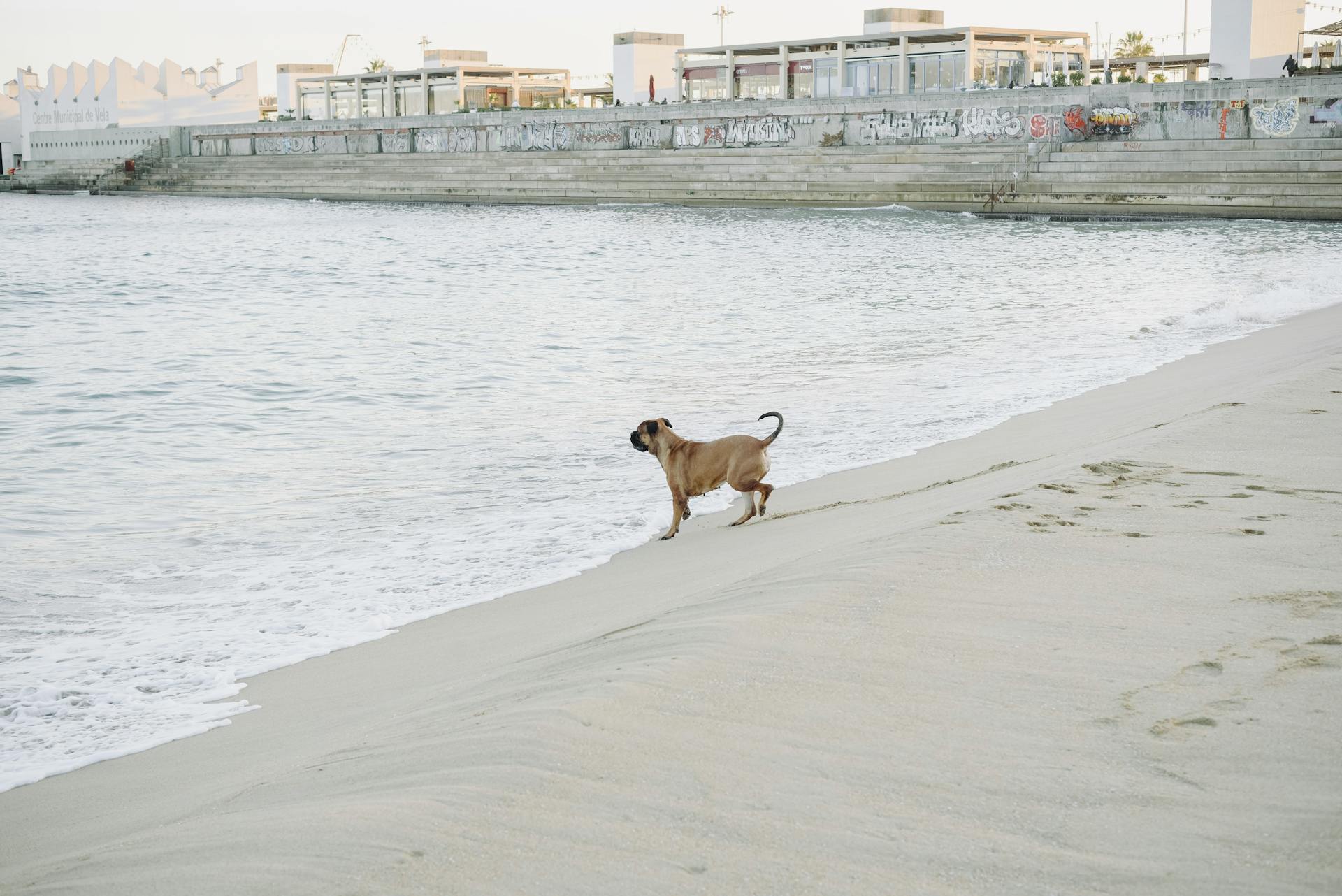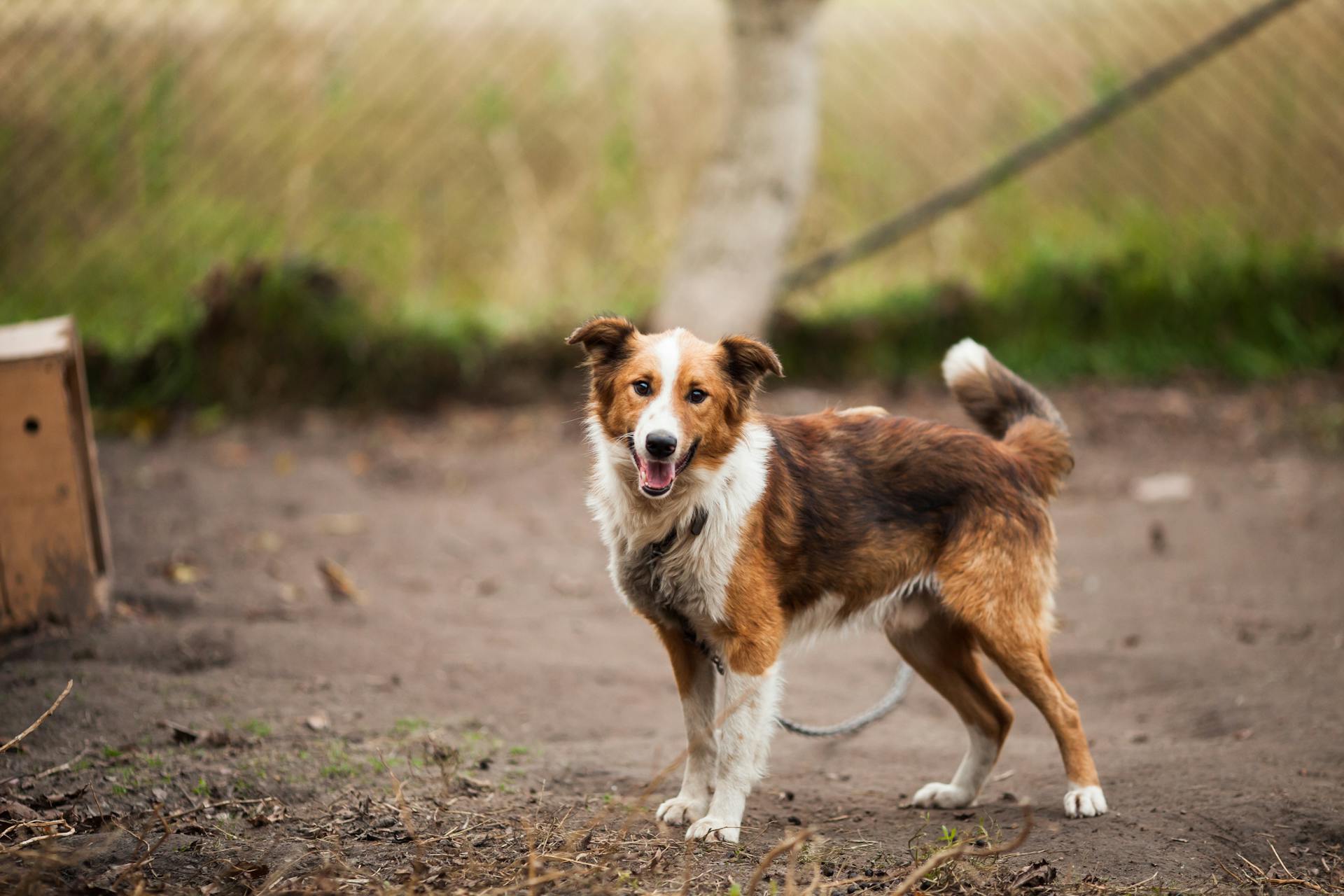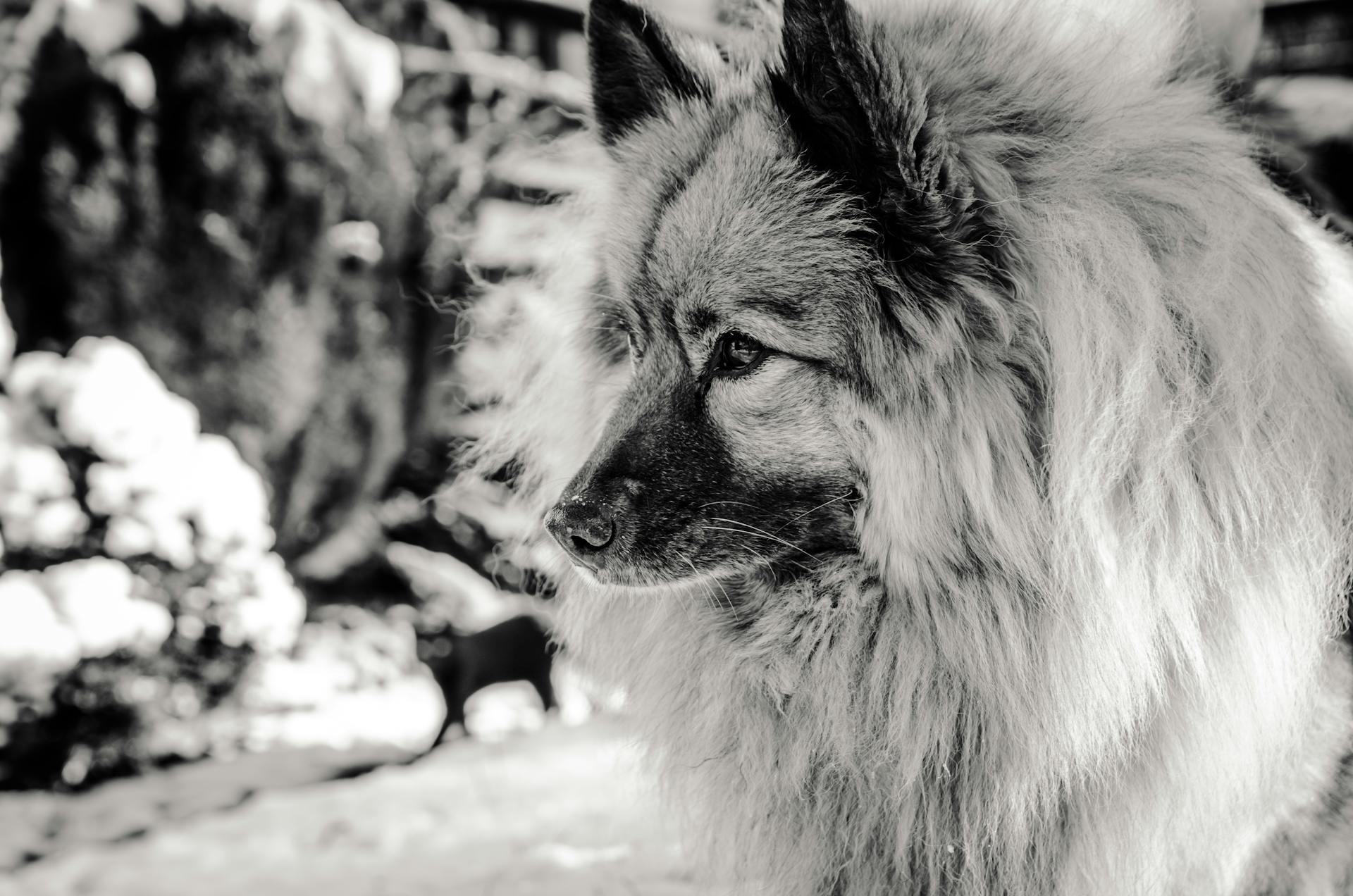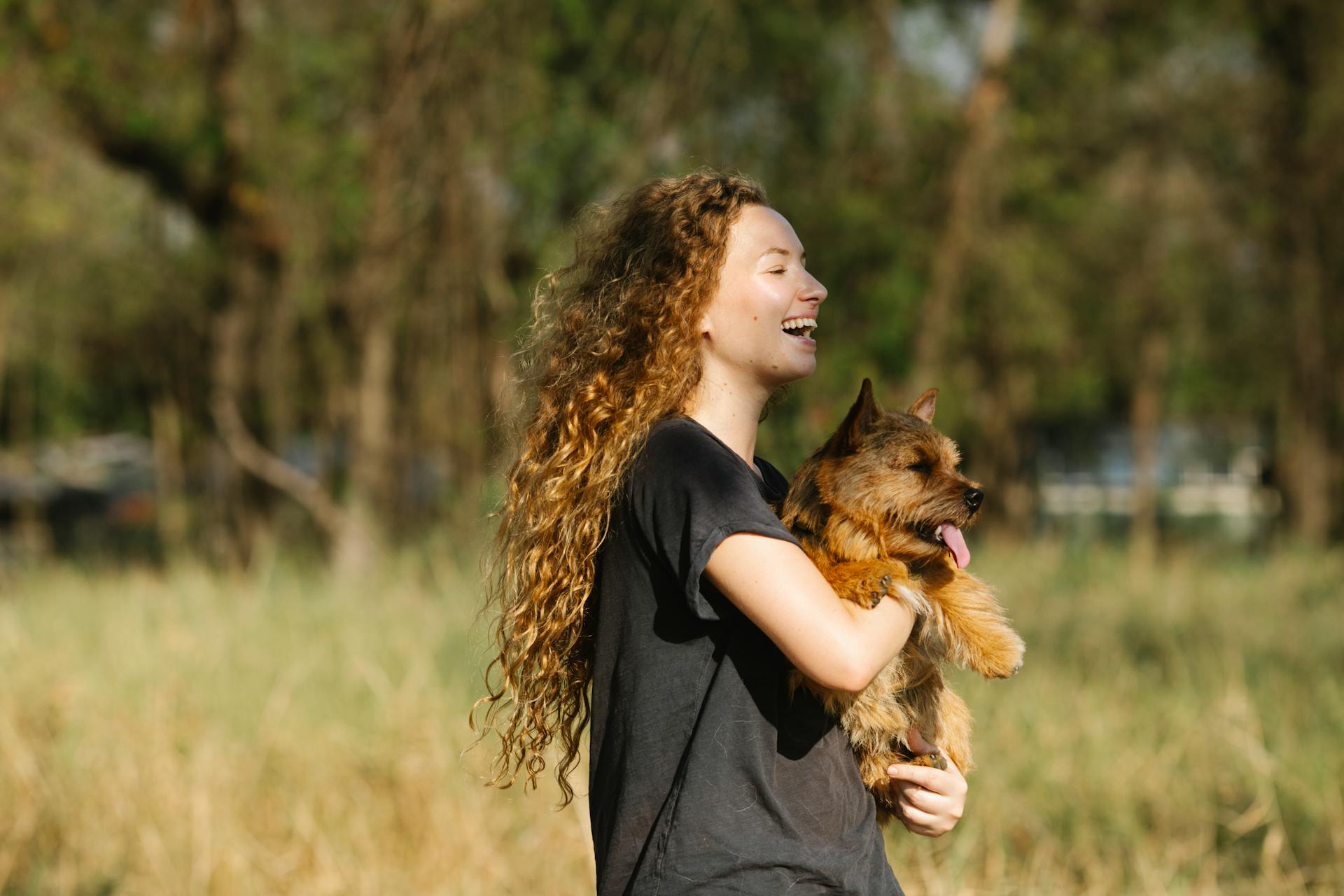
As an adult Bullmastiff owner, you're likely aware that these gentle giants require regular exercise to maintain their physical and mental health. Adult Bullmastiffs need at least 30 minutes of exercise per day, which can be a combination of walks, runs, and playtime.
Bullmastiffs are prone to hip dysplasia, a genetic condition that affects the hip joint, so regular exercise is crucial to maintain their joint health. This can be achieved through short, gentle walks and playtime in the yard.
Adult Bullmastiffs typically weigh between 110-130 pounds and stand between 23-27 inches tall at the shoulder. Their short coats require minimal grooming but do shed heavily, especially during seasonal changes.
To ensure your Bullmastiff stays healthy, it's essential to monitor their weight and adjust their food intake accordingly. A general rule of thumb is to feed them 2-3% of their body weight in food daily, divided into two meals.
Recommended read: Is It Ok to Feed Older Dogs Puppy Food
Caring for Large Breed Dogs
Adult bullmastiffs are a joy to care for, but they do require some special attention.
Their short, dense coat is easy to maintain with regular brushing, which should be done every 2 to 3 days with a slicker brush and a bristle brush.
A daily walk and playtime spent in a fenced-in yard are great ways to prevent obesity and boredom in your bullmastiff.
You'll need to brush their teeth at least 2 to 3 times weekly to prevent decay and periodontal disease.
Their nails should be trimmed about once a month to prevent clicking on the floor.
Bullmastiffs don't shed as much as some other breeds, but they do shed more frequently during seasonal changes, so be prepared to brush them more often during these times.
Their ears should be checked weekly for debris and any signs of infection, and cleaned if needed.
Bullmastiffs are sensitive to hot weather, so plan your outdoor activities around the cooler parts of the day.
A high-quality and well-balanced diet is essential for your bullmastiff, and you should look for a food that meets standards set forth by the Association of American Feed Control Officials (AAFCO).
Puppies need specific nutrition for their developing musculoskeletal systems, and you should feed them a puppy food specifically formulated for large dog breeds.
As your bullmastiff grows, they'll need more exercise to stay in shape, but be careful not to overdo it, as they can put on weight easily.
Regular check-ups with your veterinarian are essential to catch any potential health problems early on, and pet health insurance can help cover the costs of these visits.
See what others are reading: When Do Dogs Switch to Adult Food
Health and Wellness
Bullmastiffs are prone to certain health issues, but with proper care and attention, you can help your adult Bullmastiff live a happy and long life. Large-breed dogs like the Bullmastiff often suffer from hereditary problems such as hip and elbow dysplasia.
To prevent or manage these issues, it's essential to maintain a healthy weight, provide regular exercise, and in older dogs, give joint supplements. Regular veterinary check-ups and screenings can also help identify potential problems early on. Brushing your dog's teeth daily will prevent periodontal disease, and keeping your dog's diet consistent and avoiding people food can also help prevent certain health issues.
Worth a look: Bullmastiff Health Problems
Here are some common health concerns to watch out for:
- Change in appetite or water consumption
- Tartar build-up, bad breath, red gums, or broken teeth
- Itchy skin (scratching, chewing or licking), hair loss
- Lethargy, mental dullness, or excessive sleeping
- Fearfulness, aggression, or other behavioral changes
If you notice any of these symptoms, it's essential to seek veterinary help as soon as possible. Regular check-ups and a healthy lifestyle can go a long way in keeping your adult Bullmastiff happy and healthy.
Eye Problems
Eye problems can have a dramatic impact on a dog's quality of life, and Bullmastiffs are especially prone to certain conditions.
Entropion is a painful condition where the eyelid rolls inward, causing the eyelashes to rub against the cornea. This can lead to blindness if not treated.
Bullmastiffs are at risk for heritable entropion, which can be surgically corrected if caught early.
Glaucoma is an extremely painful disease that rapidly leads to blindness if left untreated, and it's a medical emergency that requires immediate attention.
Symptoms of glaucoma include squinting, watery eyes, bluing of the cornea, and redness in the whites of the eyes.
Cataracts are a common cause of blindness in older Bullmastiffs, and they can be identified by cloudy lenses during an examination.
Surgery to remove cataracts and restore sight may be an option for some dogs.
Health

Bullmastiffs are prone to certain health issues, including hip and elbow dysplasia, gastric dilatation-volvulus (GDV), cancer, dilated cardiomyopathy (DCM), and entropion. These conditions can be managed with proper care and attention.
To prevent hip and elbow dysplasia, ask your breeder if the parents have been health screened and had their hips and elbows certified by OFA. Regular exercise and maintaining a healthy weight can also help manage these issues.
Gastric dilatation-volvulus (GDV) is a life-threatening condition that can be prevented by feeding your pup two or three smaller meals throughout the day and using a slow feeder bowl. Avoid exercise within an hour of eating.
Cancer is a common issue in Bullmastiffs, with lymphoma and mast cell tumors being the most common types. Lymphoma can be treated with chemotherapy, while mast cell tumors are often treated with radiation.
Dilated cardiomyopathy (DCM) is a common heart disease in large breed dogs, including Bullmastiffs. A genetic screening test is available, and treatment typically involves daily medication.

Entropion is a condition where the eyelid rolls inward, causing irritation and potentially leading to blindness. Regular eye exams can help detect this condition early on.
Here are some common signs of illness in Bullmastiffs:
- Change in appetite or water consumption
- Tartar build-up, bad breath, red gums, or broken teeth
- Itchy skin (scratching, chewing or licking), hair loss
- Lethargy, mental dullness, or excessive sleeping
- Fearfulness, aggression, or other behavioral changes
Regular veterinary check-ups and a healthy lifestyle can go a long way in preventing and managing these health issues.
Owning an Adult Bullmastiff
Owning an adult Bullmastiff requires a gentle and positive approach, as they are a sensitive breed. They thrive on attention and patience, especially if you've had them since a young age.
Their size is a significant consideration, from their food and exercise needs to their training requirements. Everything centers on their enormous bodies and potential challenges.
As a loyal breed, Bullmastiffs are naturally protective of their family and territory. If not socialized properly, they can become overprotective.
Early obedience training and socialization are crucial for adult Bullmastiffs. This helps them become confident and reliable companions.
Here are some key characteristics to keep in mind when owning an adult Bullmastiff:
With the right care and attention, adult Bullmastiffs can be loving and loyal companions. They're known to be docile and loving towards children, making them a great addition to many families.
Temperament and Behavior
Adult bullmastiffs are known for their affectionate and happy-go-lucky nature, forming deep bonds with their humans and making them faithful companions.
They're not much of a barker, as they were bred to be silent hunters. You wouldn't even know they're around, except for the fact that they'll often be leaning against your leg or trying to fold themselves into your lap.
Bullmastiffs are not naturally aggressive and are not known for biting, even though they have a powerful bite force. However, they can be wary of strangers, so it's essential to start training your bullmastiff puppy early to help them get used to having visitors in your home.
Here are some key traits to consider when interacting with your adult bullmastiff:
Overall, adult bullmastiffs are delightful family dogs with a calm and gentle demeanor, making them a great addition to many families.
Getting Started in Dog Sports
If you're new to dog sports, it's essential to start with the basics. Intro to Dog Sports is a great place to begin, covering the fundamentals of dog sports and what to expect.
You can enroll your mixed-breed dog in canine partners programs, which is a fantastic way to get started. Many of these programs are designed to be inclusive and welcoming to dogs of all breeds.
Titles and abbreviations can be confusing, but don't worry – it's easy to learn. Familiarize yourself with common titles and abbreviations used in dog sports to ensure you're on the right track.
To determine which sport is best for you and your dog, consider their energy level, breed, and temperament. Some sports are more suited to high-energy dogs, while others are better for more laid-back companions.
Get Started in Dog Training is a crucial step before diving into dog sports. This section will guide you through the process of training your dog and preparing them for competition.
If you're unable to attend in-person events, don't worry – Virtual Dog Sports & Events are becoming increasingly popular. Many organizations now offer virtual events and online competitions, making it easier than ever to participate in dog sports from the comfort of your own home.
Temperament
Bullmastiffs are naturally quiet dogs, bred to sneak up on poachers without alerting them. They're not big barkers, which makes them a great choice for homes with noise restrictions.
Their calm demeanor is perfect for families with children, who can often be clumsy around large dogs. Bullmastiffs are highly tolerant of this handling and will even protect their family members from day one.
They're not naturally aggressive, but can be wary of strangers, so early training is essential to help them feel comfortable around visitors. This training should start from an early age, when they're still a puppy.

Bullmastiffs are also sensitive dogs, requiring a gentle and positive approach from their owners. They're aware of their family's needs and will respond to patient and attentive owners.
Their size is a consideration when it comes to supplies and exercise, but with the right care, they can thrive. With patience and attention from a young age, you can minimize situations that demand correction and ensure a happy, outgoing dog.
Here are some key temperament traits to keep in mind:
- Naturally quiet and not prone to barking
- Highly tolerant of children and their handling
- Not naturally aggressive, but can be wary of strangers
- Sensitive and require a gentle, positive approach
- Require patient and attentive owners
General Information
The Bullmastiff is a relatively new breed that originated in England in 1860. They were bred to be a capable yet disciplined helper for gamekeepers on English estates.
The Bullmastiff's mix of 60% Mastiff and 40% Bulldog makes them quick, powerful, and stealthy. This unique combination also gives them a strong sense of loyalty and intelligence.
Bullmastiffs are highly trainable, but they can be stubborn at times.
Breed History
The Bullmastiff breed has a rich history that dates back to 19th-century England. The breed was created to serve as a guardian dog for gamekeepers, who needed a dog that could catch poachers without being too aggressive.
With the Industrial Revolution in full force, people were struggling to put food on the table and turned to poaching game, which came with severe punishment. This led to the development of the Bullmastiff, a cross between the Mastiff and the Bulldog.
The breed was first bred in the 1790s to create a dog that was large and powerful, yet calm and quiet. This made them perfect for guarding game at night, where they would keep an eye out for poachers and then quietly pursue and pin them down until the gamekeepers arrived.
The Bullmastiff quickly became a popular show dog, with gamekeepers competing over who had the most-prized dog. The breed was also used to guard the De Beers diamond mines in South Africa in the late 1920s.
Today, the Bullmastiff is recognized as a breed by the American Kennel Club and is valued for its intelligence, trainability, bravery, and ability to work independently.
Breed Appearance

The Bullmastiff is a majestic breed with a strong and muscular body. They can grow quite large, but their size won't stop them from trying to snuggle up on your lap.
Their broad, wrinkled head is a distinctive feature, with a dark face mask and short, square muzzle. This gives them a unique appearance that's often compared to an oversized Pug.
Bullmastiffs have dark, medium-sized eyes that are a deep dark hazel color. Their eyes are alert and expressive, giving them a intelligent and curious look.
Their ears are V-shaped and held close to the cheeks, giving them a endearing and floppy appearance. This is a key characteristic of the breed.
The Bullmastiff's coat is short and dense, with a subtle texture that's slightly rough to the touch. They come in a range of colors, including red, fawn, and brindle.
Here are the key features of the Bullmastiff's appearance:
- Ears: V-shaped and held close to the cheeks
- Coat Length: Short and dense
- Coat Color: Red, fawn, or brindle (with a small white spot on the chest)
- Tail: Long and straight or curved
Dog Breed
The Bullmastiff dog breed is a unique and fascinating breed with a rich history. They originated in England in 1860 as a mix of English Mastiffs and Bulldogs.
Their appearance is quite distinctive, with a broad, wrinkled head and a short, square muzzle. Their ears are V-shaped and floppy, held close to their cheeks. They have dark, medium-sized eyes and a squished, black nose with large nostrils.
The Bullmastiff's coat is short and dense, coming in a range of colors including red, fawn, and brindle. They may have a small white spot on their chest. Their tails are long and can be either straight or curved.
One of the most notable things about the Bullmastiff is their temperament. They are loyal, intelligent, courageous, confident, alert, docile, wary, and trainable, but can also be stubborn at times. This unique combination of traits makes them an excellent breed for families with older children or those looking for a guardian dog.
Here are some key characteristics of the Bullmastiff breed:
- Coat length: Short and dense
- Coat color: Red, fawn, brindle, or a combination of these
- Tail type: Long, straight or curved
- Ears: V-shaped and floppy
- Nose type: Squished and black
Frequently Asked Questions
How big is a full grown Bullmastiff?
A full-grown Bullmastiff typically stands 27 inches tall and weighs between 100-130 pounds. This breed is a large and impressive dog.
What are the weaknesses of a Bullmastiff?
Bullmastiffs are prone to health issues such as hip dysplasia, eyelid problems, and cardiac diseases, as well as a higher risk of certain cancers. Regular veterinary care and genetic testing can help identify potential health concerns early on.
Featured Images: pexels.com


